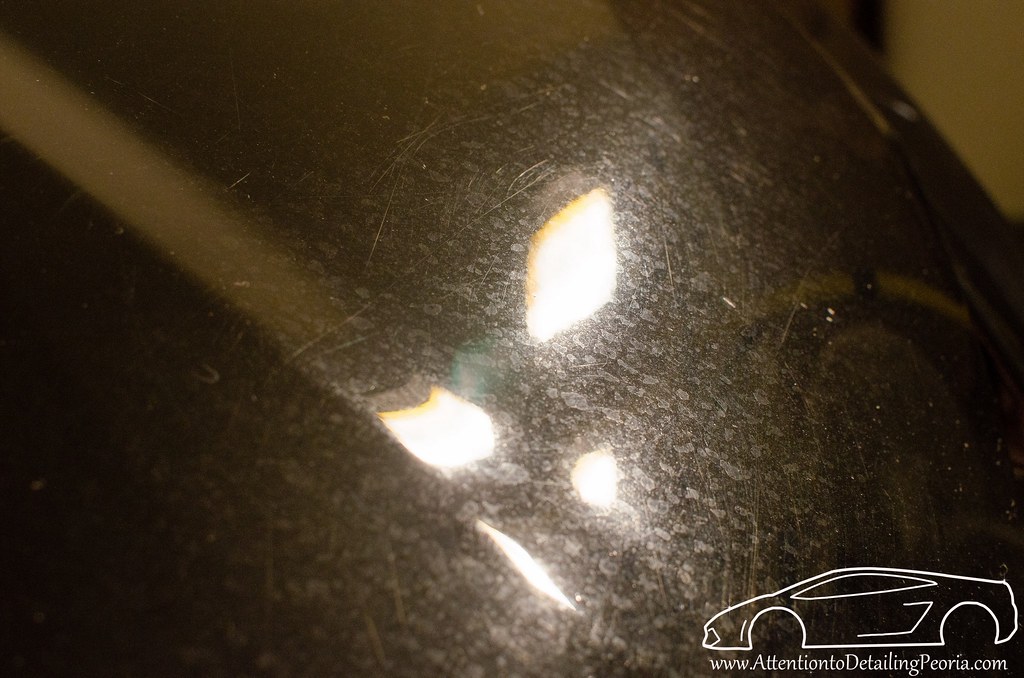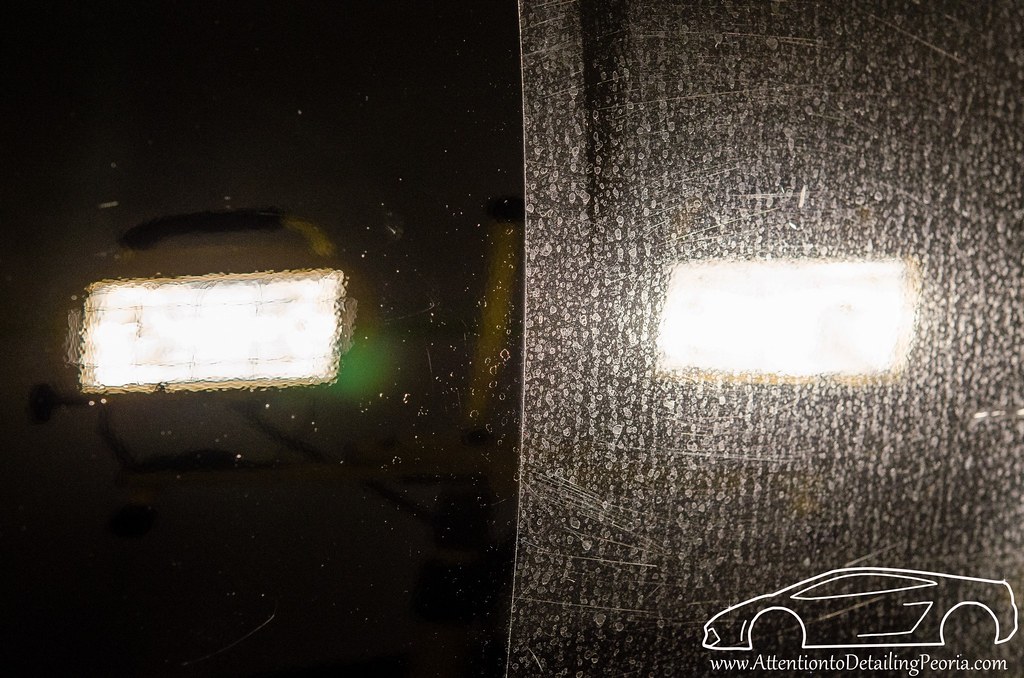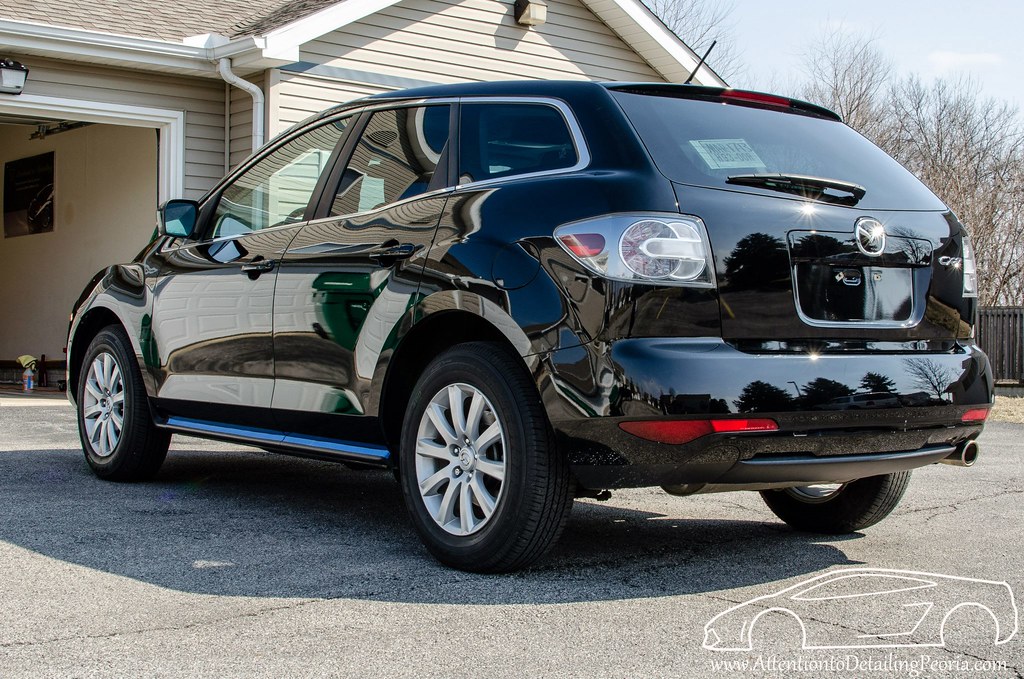Removing Water Spots
by Zach McGovernIn my first article about Water Spots, we discussed the science behind water spotting, and the resulting damage that can occur when water spots are left on your vehicle. In this article, we will explore the various ways to remove water spot deposits and etching.
Mineral Deposits (Above Surface Contamination)
As we previously discussed, when beads of hard water dry on your paint, the water evaporates leaving mineral deposits behind. These deposits are what you can see and feel on the surface of the paint.

There are several ways to attempt to remove mineral deposits from your paint. The first choice is simply to try washing your car. If the spots are not too severe, or are new, they may simply wash away. If that does not work, grab your clay bar before you dry the car and do a test spot. Detailing Clay is used to remove all sorts of bonded surface contaminates, and can be effective at removing some water spot deposits as well.
If you’re unable to remove the deposits with washing or claying, and you are certain the defect you are seeing is an above surface defect, then you should consider purchasing a dedicated water spot removal product like CarPro Spotless or Optimum MDR. Hard water is more alkaline (pH greater than 7) than pure water due to the high mineral content, therefore most water spot removers are usually acidic (pH lower than 7) in order to neutralize the deposits. These products can make quick work of mineral deposits. For more information, check out my Product Review of CarPro Spotless.
Etching (Below Surface Defects)
If you have tried washing, claying, and water spot removers but haven’t been able to remove the spotting, chances are you’re dealing with a below surface defect. The minerals that form the water spot can start to eat into your paint creating a small etching below the surface of the clear coat. Like swirls and scratches, these etchings are repaired by removing paint in order to level the surface. In order to do this, we must begin a paint correction process utilizing various pads, products, and machines to refine the surface and eliminate the defects.
I mention this quite often, so I might as well say it again, but it is always important to start with the least aggressive method and work your way up. Clear coat is quite thin, and if you jump right to a heavy cutting pad and cutting compound, you’ll most likely see good defect removal, however you may be removing more paint than is needed to level the particular defect therefore you’re “wasting” valuable clear coat. Water spot etchings can become very severe, however it is still important to take the time to analyze the defects and perform the necessary test spots to determine the best process to remove your unique defects.

As you can see in the image above, this vehicle was plagued with an incredible amount of hard water spots (owner must have parked by a sprinkler for years as the damage was only to one side). The left side of the photo has undergone a 2 step paint correction process, and you will notice there are still some heavy etchings that remain (notice how you can actually see the ‘crater’ left in the paint). Due to the very thin paint on this car, I was not willing to go any further with the correction, therefore this damage can be considered permanent. With that being said, the improvement was still drastic and the overall appearance of the car was dramatically enhanced after the correction process as seen below.

Once the water spots deposits and/or etchings have been removed, it is a great idea to add a new layer of protection to your vehicle to help protect the paint from future spotting and other environmental contamination.









Great write up…. this vehicle had some some pretty serious water spots!. Great job removing them!
Thanks!
Zach, thank you for the well written review above. I detail my cars as a hobby and appreciate the reviews and articles here. I’m curious if either the CarPro or Optimum products can be used on matte black plastic trim around the windows on GM cars? If not, any recommendations on what product to use for water spots on that type of surface? Thanks Ken
Hi Ken – both products specifically state they can remove spots from “paint, chrome, and glass”. I have never tried a spot remover on plastic, so I cannot speak to the results that you may have. If the trim is a surface that responds well to dressing, then I would simply clean the area thoroughly and apply a dressing like 303 or if you wanted a longer lasting option, CarPro DLUX or 22ple VR1 are both great!
Zack
I’ve recently worked on vehicles with water spots etched into the paint. I was able to improve the paint appearance but unable to remove all the etching. I tried wet sanding a test spot with 3000 grit but even that didnt help.
Based on your experience, how do you determine when to continue removing etching and when do you call it a day.?
Would you also wet sand to remove etching?
Thank you
Greg
Hey Greg – sounds like you had some severe etching to deal with. As I mentioned in this article when referencing the 50/50 shot, sometimes etchings are too severe to safely remove. I use my paint thickness gauge to provide a reference as to how much material I may have to work with before getting too aggressive. In the instance above, I was working on extremely thin paint, so sanding was not an option in my opinion, however if I had healthier paint thickness to work with and the owner was seeking perfection, it would be something that I would certainly consider. There is a point where you have to determine if chasing severe defects are worth the risk, or if preserving the clear coat is a better choice. Hope that helps.
Zach, I live in an area where water spotting is some of an issue if I can’t get the truck dried fast enough. Basically its a beat-the-clock game. In fact sometimes I actually wash part, like the roof and windows, and then dry before continuing. Looking at the spotless water systems and the cost I’m wondering if I’d get the same benefit if I used that filtered water just for final rinsing. I use a lot of water when washing so using it for the entire process could get expensive. Thoughts/suggestions?
Hey Todd – yes, as I understand it that is a common practice to simply switch to the de-ionized water for the final rinse instead of the entire wash process. You may also consider rinseless washing as you work panel-by-panel instead of trying to wash the entire truck at once and then hurry up to dry it.